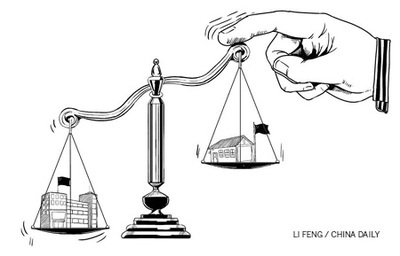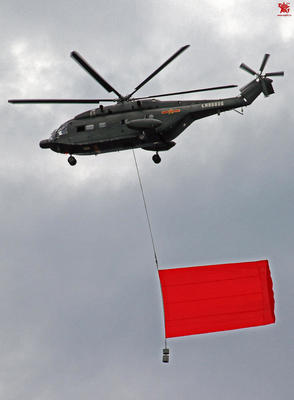The System of Vocational Education andIts Development
The system of vocational education consists ofeducation in vocational schools and vocational training.
Vocational education in China is provided at three levels:junior secondary, senior secondary and tertiary.
Conducted mainly in junior vocational schools and aimed attraining workers, peasants and employees in other sectors withbasic professional knowledge and certain professional skills,junior vocational education refers to the vocational and technicaleducation after primary school education and is a part of the9-year compulsory education. The students in secondary vocationalschool should be primary school graduates or the youth withequivalent cultural knowledge and its schooling lasts 3 to 4 years.To meet the needs of labor forces for the development of ruraleconomy, junior vocational schools are mainly located in ruralareas where the economy is less developed.
The secondary level mainly refers to the vocational educationin senior high school stage. Composed of specialized secondaryschools, skill workers schools and vocational high schools, and asthe mainstay of vocational education in China, secondary vocationaleducation plays a guiding role in training manpower with practicalskills at primary and secondary levels of various types.
Consisting of secondary technical schools and normalschoo1s, specialized secondary schools enroll junior high schoolgraduates with a schooling of usually 4 years and sometimes 3years, A few specialities are open only to senior high schoolgraduates with the schooling lasting 2 years. The basic tasks ofthese schools are to train secondary-level specialized andtechnical talents for the forefront of production, and all thestudents should master the basic knowledge, theory and skills oftheir speciality in addition to the cultural knowledge required forhigher school students.
Aiming at training secondary-level skill workers, skillworker schools enroll junior high school graduates and theirschooling lasts 3 years. Quite capable of practicing and operating,their graduates will directly be engaged in productionactivities.
Developing on the basis of the structural reform ofsecondary education after China adopted the policy of reform andopening to the outside world and directly coming from thereorganization of regular high schools, vocational high schoolenrolls junior high school graduates and its schooling lasts 3years. Its main task is to train secondary-1evel practice-orientedtalents with comprehensive professional abilities and all-roundqualities directly engaged in the forefront of production, service,technology and management. Accordingly, the specialities offered invocational high schools are mainly related to the thirdindustry.
In 2001, there were altogether 17,770 secondary vocationalschools (including vocational high schools, specialized secondaryschools and skill workers school), with the enrollment of11,642,300 students and the recruitment of 3,976,300 students.
With the schooling lasting 2 to 3 years,tertiary vocational education mainly enroll graduates from regularhigh schools and secondary vocational schools. In recent years, theproportion of graduates form secondary vocational schools has beenincreased, establishing the link between secondary and tertiaryvocational education gradually. Aiming at training secondary andhigh - level specialized technical and management talents needed inthe economic construction, tertiary vocational education emphasiz6sthe training of practice-oriented and craft-oriented talents. Atpresent, institutions providing tertiary vocational education aredivided into four categories. The first is the higher vocationaltechnology institutions; the second is the 5-year higher vocationalclasses provided in the regular specialized secondary schools; thethird is the tertiary vocational education provided in some regularhigher education institutions and adult higher educationinstitutions; the last is the reformed regular institutionsoffering 2 to 3-year higher education with the emphasis on trainingpractice-oriented talents, namely high-level professional technicaltalents, for the forefront of production.
Vocational training of various forms has been playing a moreand more important role in vocational education. At present,vocational training is mainly conducted and managed by thedepartments of education and labor, but enterprises are encouragedto provide vocational training for its own employees. In 2001,short-term training are proved for 100 million person-time.
The Achievements of Vocational Educationin China
1.The Rapid Expansion of the Scale of VocationalEducation
During the l5 years between 1980 and 2001, the proportion ofregular senior high school students among all the students insenior secondary education has decreased from 81% to 54.7%, whilethe proportion of secondary vocational school students hasincreased from 19% to 45.3%. From l980 to 2001, secondaryvocational education institutions produced 50 million graduates,fostering millions of secondary-level and primary-level technicalworkers, managers, skill workers and other labors with goodvocational and technical education.
2.The Big Stride Made in the Construction of VocationalEducation Teachers
Teachers for vocational education are mostly graduates fromregular higher education institutions. Since 1989, over 160 HEIshave established departments, specialities or classes devoted tothe training of vocational education teachers. At the same time,the government began the establishment of teacher training basesfor vocational education, Nowadays, there are over 50 trainingbases set by vocational technical colleges which are affiliated toHEIs and over 200 bases set by central departments and localgovernments. As a result, a training bases network has basicallytaken shape, meeting the needs of teacher training for vocationaleducation of various forms and at various levels.
3.The Increase of the Quality and Level of VocationalEducation
During the past 50 years, especially the 20 years afterreform and opening to the outside world, much attention has beenpaid to the quality and level of vocation education as well as theschooling efficiency. Meanwhile its scale has been extraordinaryexpanded. By the end of 2001, more than 3000 key and pilotvocational schools have been established, promoting the overalldevelopment of vocational education.
4.The Primary Fruits of the Teaching Reform of VocationalEducation
Learning the foreign modern vocational education thought andteaching patterns to improve the level of teaching is an importantcomponent of the reform of vocational education, For example, the"dual-track system " of Germany, the educational and trainingpattern based on the ability in Australia and Canada, theEmployment Education Structure (MES) advocated by the World LaborOrganization, the " Skill Courses for Starting Small Enterprises"initiated by the UNECO and the " Business and Trade SimulatedCompany" springing up widely all over the world, all became themodels for the reform of Chinese vocational education in China.
5.Rapid Development of Vocational Education in RuralAreas
Since the 1980's, significant progress has been made invocational education in rural areas of China with its quantitygreatly enlarged and quality greatly improved.
6. More and More Important Role Played by Research on VocationalEducation
With the development of vocational education, research onvocational education has been enhanced and a number of vocationaleducation research institutions have been established, organizingthe full-time and part-time research teams composed jointly byadministrative departments responsible for vocational education,research institutions, vocational schools and academicorganizations, carrying out various forms of vocational educationresearch at different levels.
International Cooperation and Exchangeson Chinese Vocational Education
Internationalization has become a common trend for thereform and development of modern education in the world. Along withthe reform and opening to the outside world, China has beenactively engaged in the international cooperation and exchanges inthe field of vocational education. During the past 20 years, thegovernment has sent many delegations to over 20 countries anddistricts where vocational education is well-developed and showstheir unique characteristics to learn successful foreignexperience. At the same time, China has received many foreignvocational education delegations, invited foreign experts to givelectures in China, and jointly provided education with foreignvocational education institutions to promote the development ofChinese vocational education, China has also made more and morecontact with the UNESCO, UNDP, world Labor Organization, UNPF, APECand other international organizations while the bilateralcooperation and exchanges between China and other countries hasbeen increasingly expanded.
文章引用自:http://www.moe.edu.cn/english/vocational_v.htm
 爱华网
爱华网

